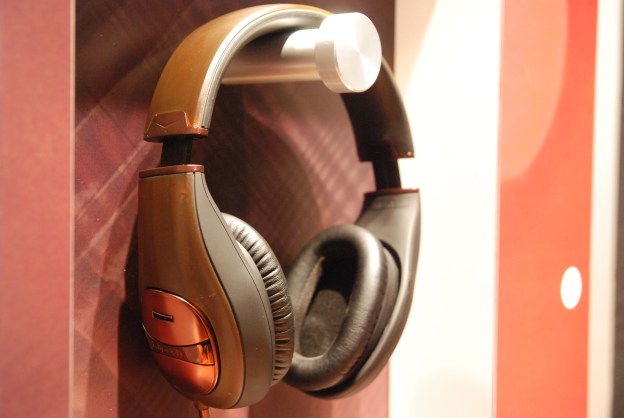
We got a chance to lay our hands and ears on Klipsch’s first-ever set of noise cancelling headphones today at the CEDIA 2011 expo. If you missed our overview of the Klipsch Mode from last month, here’s a quick refresher:
The Mode M40 are active noise-cancelling headphones that run off a single AAA-size battery. Though battery power is required for the noise-cancelling function, it isn’t necessary for the headphones to perform. When the battery runs out, the jams keep pumping. The Mode have a cloth-covered cable and sport the smooth copper and bronze look of Klipsch’s Reference line of speakers and recently introduced Reference headphones. Packed inside each earcup are two drivers, one 40mm woofer and a 15mm tweeter.
As we took the Mode in our hands, the headphones felt well-built and sturdy. The earcups are lined with a super soft material and very well padded. The illuminated button used to turn the noise-cancelling feature on or off is located on the outside of the right earcup. We found the button small enough not to call attention to itself, yet a little tricky to turn on and off while being worn. We also felt that the rendered image Klipsch has been circulating didn’t exactly match what we saw today, though Klipsch did inform us the final production models would be slightly different. It seems like the material that made up the headband was significantly lighter in color than we expected, but it was still attractive enough.
The Mode fit securely on our head without a lot of undue pressure. Our guess is that these cans will wear nicely for long periods of time, though we’ll have to wait for review samples to make a proper evaluation. The Mode provide a good amount of passive noise isolation but engaging the noise-cancelling feature also did plenty to quiet the noisy expo floor.
We had our iPhone handy and used it to play some familiar songs. Our immediate impression of the Mode sound: Punchy. The bass, while not overwhelming, certainly has a robust attitude that makes a solid statement. It is hard not to think that Klipsch put a target on the back of the Beats by Dr. Dre line from Monster when voicing these headphones.
What we liked most about the music we heard from the Mode was that the midrange frequencies and, more specifically, vocal timbre, were unaffected by the punchy bass. Vocals were up front in the mix and sounded well balanced. High frequencies were surprisingly well controlled. We’ve come to expect relatively bright treble with Klipsch products, but the Mode managed to offer plenty of sparkle without stabbing at our ears.
The fact that we were able to hear anything at all is a testament to the Mode’s ample noise-cancelling capabilities but we look forward to hearing more and making a more thorough evaluation in the near future. Klipsch says we can expect to see the Mode hit shelves late this fall.



